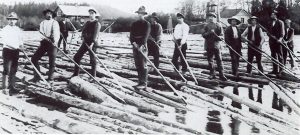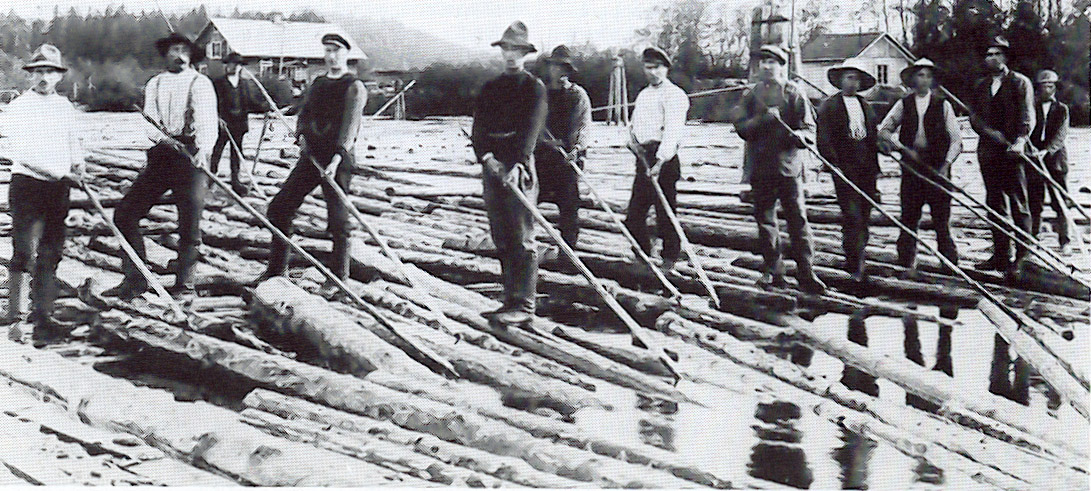
It was her third adjustment. She had already endured my chiropractic monologue over the previous two visits — explaining the basics of chiropractic and how it related to her. So, you’ll understand then, I was a bit surprised when, as I was preparing to adjust her, she asked, “Just what is it that you are DOING?”
“Doing?” I responded. “I’m adjusting you,” I stated matter-of-factly.
“Yes, I realize that,” she returned. “But just what is it that the adjustment is DOING?”
I paused, a bit disheartened, realizing that my initial communication efforts had been completely ineffective. Obviously a rehash of my script from the days before wasn’t going to cut it.
And then it hit me, as the image of a profession from yesteryear sprang forth in my mind. “What I’m doing,” I stated, “— what the adjustment is doing — is breaking up logjams.”
Logs on the Water
Back in the early days of the logging industry — mid 1800’s to early 1900’s — the main method of transporting logs to the sawmills was to literally “float” them down rivers. This method was known as “log driving” and was quite impressive. Log drives varied in their distances and number of logs transported. While some drives would take 4 to 5 days to complete, others would take months. Some drives were known to transport up to 20 million board feet of timber at a time.
Interestingly, each log was “branded” by the timber company that claimed ownership of it. Obliterating or altering this timber mark in any way was a crime. Once the log successfully reached its destination downriver at the sawmill, it was captured by a log boom and then sorted according to its mark before being sawn.
What I didn’t tell you was that conducting a log drive was not a simple dropping of a bundle of logs in a river and biding them bon voyage. No, actually a log drive was much more complicated.
You see, logs had a tendency to “bunch up” and get in a tangled mess — clogging the once free flowing drive and creating the infamous “logjam.” This was such a problem that men known as “log drivers” were employed to literally float with the drive in special boats to ensure that the logs drifted freely.
Log driving was an extremely dangerous job, as the drivers were often “surfing” the logs with their spiked boots as they moved downstream, jumping from one log to another. As one article stated, “log driving was a profession that was dangerous to life and limb, not just some of the time, but every minute.”
When a log would catch on an obstacle, such as a rock, a logjam would often form. It was the job of the log driver to free it. Freeing up a logjam could, at times, be a daunting task. Some of the jams were rather large, involving tens of thousands of logs, and could back up the river nearly a mile. Utilizing a firm understanding of physics, strong muscles, extreme agility, and a good set of tools, drivers were often able to “break” a logjam by carefully removing one or more “key logs.” With especially stubborn logjams, dynamite had to be used.
Log Driving and Chiropractic
While not quite as dangerous as the past profession of log driving, the job of chiropractic is similar in that we are ensuring that the nervous system is “flowing freely.” When one or more of the moving bones in the spine gets “stuck” or “jammed out of position,” proper nerve flow is impeded and a “logjam” of sorts is set up. This logjam (or “bonejam,” known as a subluxation) interferes with normal nerve flow — oftentimes creating pain and dysfunction. Not only does this interfere with one’s overall health, but it also makes it very difficult to heal.
With a firm understanding of anatomy, physics, and biomechanical principles, the “log driving” chiropractor utilizes specialized adjusting techniques (without relying on the use of “explosives”) to target a few “key” vertebrae to “break the logjam” in the spine — releasing proper nervous system flow and allowing health to return.
And that, in a sort of “woodsy” way, is “what the adjustment is DOING.” Suddenly I have an urge to put on a plaid shirt.
__________
Contributed by Dr. Thomas R. Lamar, DC.
[originally published in KCN, January 2009; republished from Dr. Lamar’s spinalcolumnblog.com]
________________
Sources used for this article:
“Log driving.” Wikipedia. viewed 11/27/08. http://en.wikipedia.org/wiki/Log_driving.
Pike. “Log drive on the Connecticut.” The Atlantic Monthly. July 1963, 212 (1): 29-34. http://www.theatlantic.com/unbound/bookauth/river2.htm
“Splash dam.” Wikipedia. viewed 11/27/08. http://en.wikipedia.org/wiki/Splash_dam.



